It’s easy to toss on a pair of jeans and a t-shirt then grab a sweatshirt when we’re heading out the door.
But are we dressing wisely to survive?
How exactly does one dress to survive?
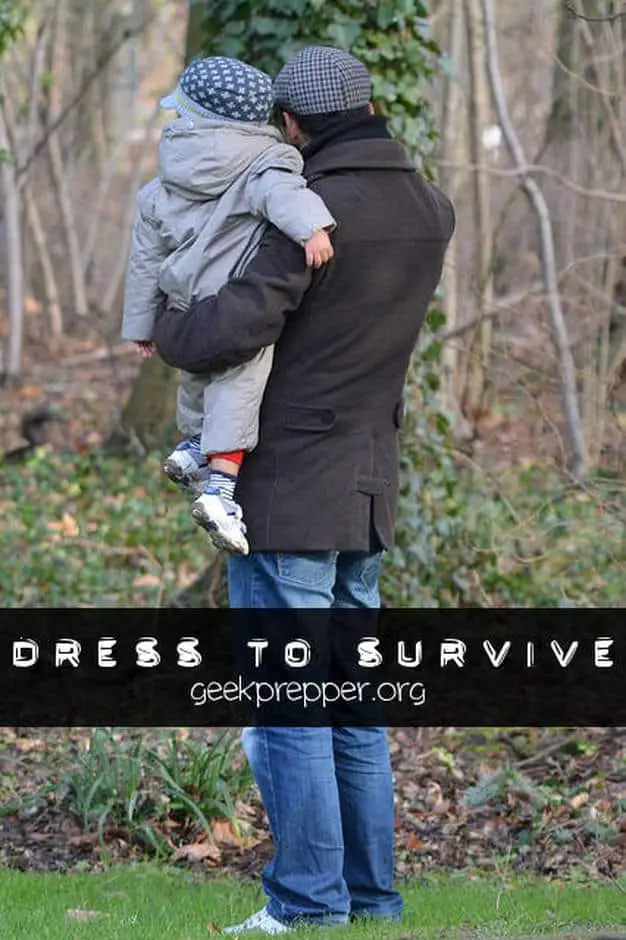
How Should You Dress to Survive?
Let me start off by saying, I’m not anti-cotton. To the contrary, I love cotton. I adore cotton. My world would fall to pieces if I couldn’t wear denim blue jeans and cotton t-shirts.
Cotton clothing is perfect for day to day wear, especially in warm weather wear. During the heat of summer or if you live near the high desert, where the humidity is low most of the year, the air is extremely dry and the temperatures remain warm, then thin cotton may be one the best materials for staying cool and dry.
Keep your cotton dry, because once it’s wet its nearly transparent to ultraviolet and will not protect against sunburn. Trust me, I learned this the hard way!

Why Do People Rag on Cotton? – Bad Pun Alert
If you live in an area where the temperatures get cool or cold, and damp or wet then cotton clothing has some characteristics that may not be beneficial.
This does not mean that if you find yourself in a survival situation wearing jeans and a T-shirt, that you should immediately disrobe and survive naked.
au contraire, my friends.
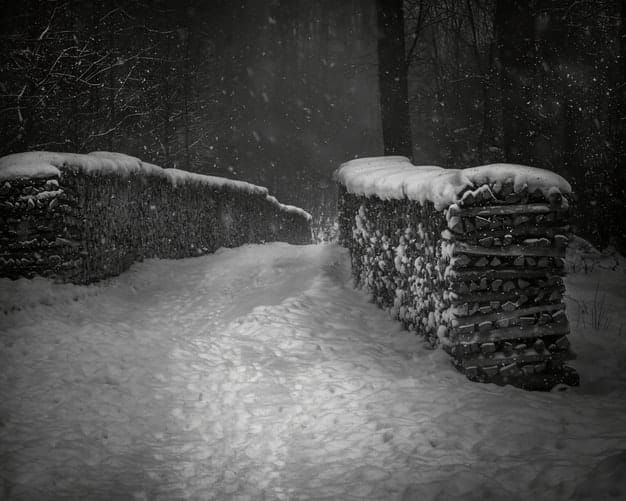
Keep your clothing on, unless it freezing outside and you get wet! Cotton acts like sponge and it does not provide insulation, once it’s wet. It soaks up water and then sucks heat from your body. In this situation removing these clothes and draping your body with something else, even dry cotton will help you retain heat.
Imagine a beautiful cool day. You are outdoors and you are sweaty or you stumble and fall into a puddle (or stream, pond, etc) and get wet, the sun is setting and the temperature starts to drop.
Your jeans and shirt, both cotton, are not going to dry. Now you’re getting colder and colder.
Your body is slowing down, you’re having a hard time thinking.
You’re developing hypothermia. Hypothermia is VERY serious.
People die of hypothermia.
Fabrics to Avoid
If you know you’ll be spending an extended period of time outdoors, in a cool-season and have a chance to get wet, then you might want to avoid these fabrics.
I’m not your mama, so you can choose for yourself, but at least I can say I warned you!
- Cotton and other cotton variants, labelled as corduroy, denim, flannel, or duck.
- Cotton blends? You should also avoid cotton blends, such as cotton-polyester. They’ll can still kill you, they’ll just kill you more slowly.
- Other manufactured fabrics, made from cellulose fiber: Modal, Rayon, Viscose, Tencel and Lyocell. These cellulose fibers absorb water faster than cotton and lose all of their insulation value when get wet.
- You should also be aware of clothing made from Bamboo fabrics. Bamboo fabrics are usually advertised as a “green product” and claim to posses characteristics comparable to wool. Many of these fabrics are actually a type of rayon and share all of its pitfalls.
- Silk is another very absorbent fabric that loses its insulation value when wet.
3 Layers of clothing
You’ll want to choose your layers based on the temperature and season, but a good rule of thumb is that your layers should get less porous as they work away from your body. Start with a breathable base layer and work your way out to a waterproof shell.
To stay warm, you need to have the following three layers:
- Wicking layer
- Insulating layer
- Outer Layer
Try to stick with earth tones or clothing that matches your environment, without making you look like you just fell out of a surplus store or tactical supply store.
Wicking Layer
You should think of your base-layer as a “wicking layer”. This is the layer closest to the skin.
Most of us wear a cotton T-shirt as our base-layer. Wet cotton does not wick water away from your skin, it holds moisture and therefore loses its ability to keep you warm when it gets wet.
Wicking fabrics, such as synthetic or wool fabrics, “wick”, or move water, from wet areas to dry ones via the process of capillary action, so your body remains dry and warm. Therefore our base-layer, should always be these synthetic or wool, wicking fabrics.
Wicking Layer Example
A wicking base-layer shirt made of a fabric, such as polypropylene or Patagonia Capilene, will move moisture from your skin to the outer layers of your shirt, leaving that fabric touching your skin nice and dry.
This is why layering is such an effective clothing strategy for survival, because wicking fabrics move the water, away from your skin and up through your multiple layers one after another, leaving the fabric, near your skin, to trap insulating air and retain your body’s heat.
Insulating Layer
An insulating layer: Go with Nylon, Polyester, Synthetic Fleece, or a wool sweater. Keep in mind, that you can find these items very inexpensively at a thrift store near you.
You can also use Pile or down, if that’s what you have available. If you do choose to use down, remember, that while it is an excellent insulator when dry, it is essentially useless when wet. Make sure to keep it dry.
Let me be the first to tell you that Nylon Zip Off Pants (aka: Convertible Pants) will be worth their weight in gold. What better way to ensure you have pants and shorts without taking up extra space? Talk about regulating temperature and giving you options. I love these and Nylon Pants, in general. What other prep blogger has the guts to tell you that?
Outer Layer
This should be a waterproof or windproof jacket, depending on the conditions. If you have the luxury of space carry both.
If it is windy, snowing or raining, add an outer layer that is impervious to those conditions.
Outerwear made from one of the fabrics that repel water but allow water vapor to pass (GORE-TEX or similar fabrics) are good for this. Remember that even those fabrics, such as GORE-TEX, are not perfect.
GORE-TEX and similar fabrics, are not as breathable as the fabrics, that are used for windbreakers. They only allow a limited amount of water vapor to pass, causing a buildup in heat and moisture, that makes your insulating layers less effective. They also may not stop heavy, wind-driven rain.
Cold Weather Layer Tips
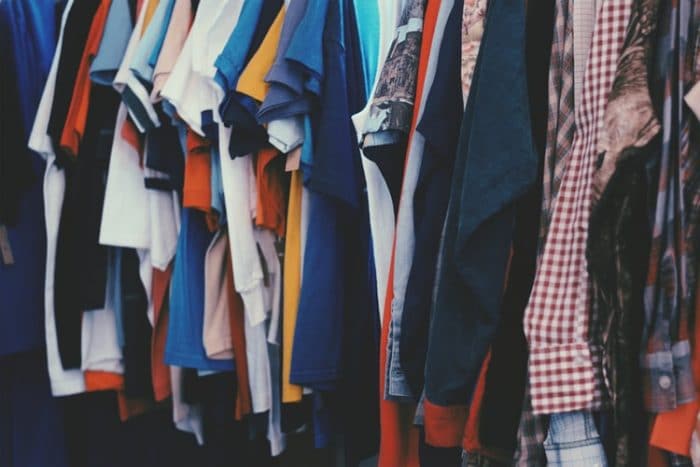
If your base-layer becomes damp and you start feeling cold, change into a dry base-layer, before you add another layer. This is a trick I like to do after I set up camp for the evening. It’s surprising how this will add a boost to your comfort and warmth.
Remove a layer before you start moving or head out. The most common error is that people wear too many layers. You should remove a layer right before you start exercise. There may be a few minutes when you’re a little chilly, but as you start moving, you’ll warm-up.
Try a few overnight trips to refine your layering system, before you embark on a full blown winter wilderness expedition. Try a few short hikes and work your way up to some overnight trips to refine your layering system. This way you can see what does and doesn’t work. You’ll be much better prepared for longer cold weather excursions.
Miscellaneous Layers
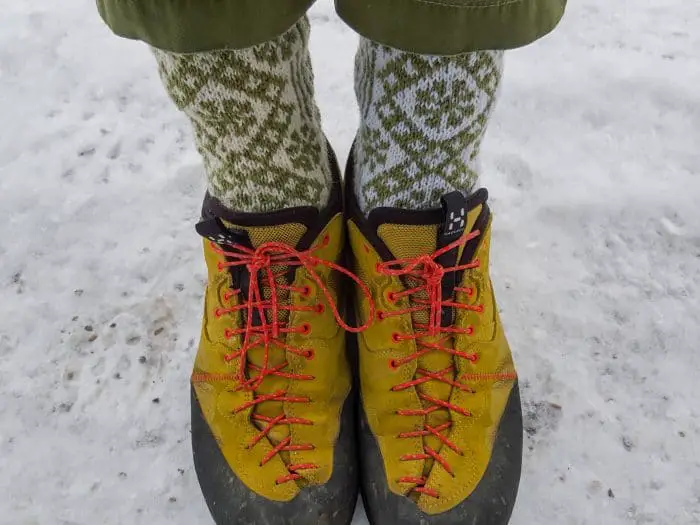
Feet
Buy good socks and boots. Always carry a change of socks. Many outdoors people prefer dual socks, an inner layer of Coolmax or polypropylene covered with wool outer socks. This allows for the two pairs of socks to slip over each other and avoid blisters.
Head
A good wool or synthetic stocking cap
Hot Weather
The trick in hot weather is to shade yourself from the sun, while allowing air to circulate near your skin.
Clothing can help keep you cool by reflecting sunlight and promoting air circulation. The white robes worn by many desert-dwelling peoples, are practical for their climate. The open area, near the skin, creates a chimney-like effect to circulate air, while the lighter colors reflect sunlight.
In this environment Cotton is good. Keep it dry though, as wet cotton is nearly transparent to ultraviolet and will not protect you against sunburn.
A hat, bandana, or shemagh to protect your head from the sun.
The general rules for Hot and Warm weather clothing are:
- Wear loose clothing to allow circulation of air near the skin.
- Wear light colors
- Protect your body (head, neck, arms and legs) from sunlight. This will prevent sunburn and reflect the sun’s rays to keep you cooler.
- Avoid sunburn, which interferes with the body’s ability to regulate heat.
Final Thoughts
For many people cotton is the main fabric in their wardrobe, but by adding some key non-cotton pieces, you should have the perfect cool or cold weather layering clothing as part of your dress to survive wardrobe .
I really wanted to call this post “How to Dress for the End of the World”, but this post goes beyond that, and covers basic extreme weather clothing sense.
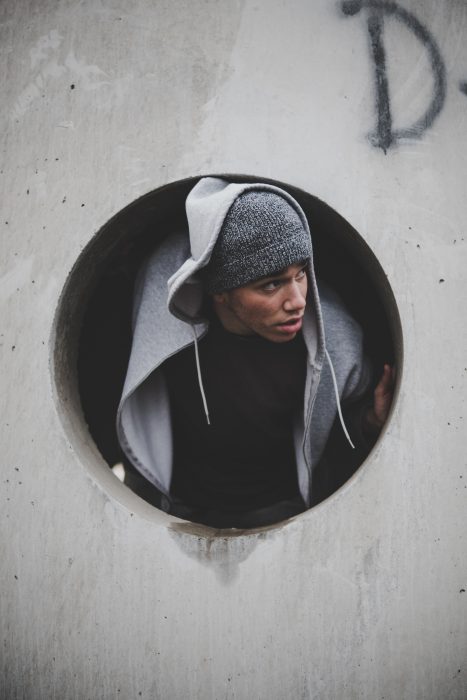


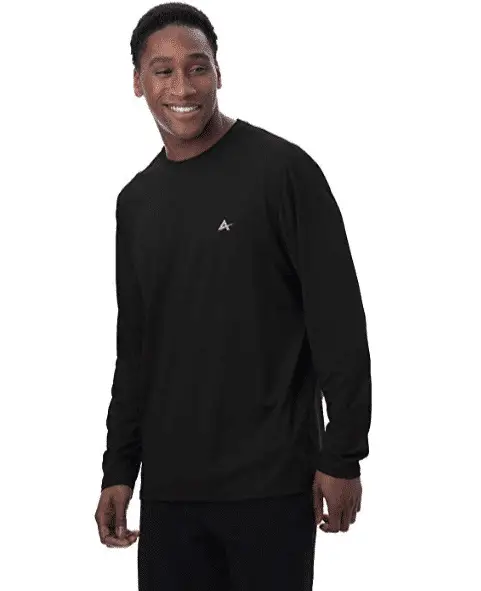


This was really useful information – thank you! I need to be better about making sure my kids dress in layers when we go up for short hikes in the mountains during the winter. They don’t last long anyway – they’re pretty young – but I bet they’d last longer if I’d be batter about layers.
Excellent post. Such crucial information. Living in California my whole life I never had to worry about it. Time to prepare for colder climates.
Loving the detailed info. I’ve been working on back packing trips and there is a lot of talk about layering and wickering, now it all came together…yay
I greatly appreciate the detailed information provided in the article. I plan to use this as a “supporting document” when educating my children about being prepared (on multiple levels) and as a guide when I purchase their clothing from now on. Thank you ever so kindly.